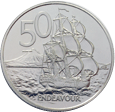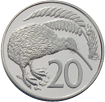
New Coins - What's changing?
This activity has students become familiar with the new 50, 20 and 10 cent coins and has them understand that 5 cent coins will not be legal currency or be able to be used after 1 November 2006.
To complete this activity students need to:
- look at the new coin poster and their copy of the new coin picture
(click here for print ready coin pictures)
It is suggested that you assemble a 'feel' or 'grab' bag that can be used to determine if students can identify coins without seeing them.
    
The new coins
- Ask the students why they think we are changing our coins. To answer this have the students focus on the differences they observed.
The new coins are much smaller and lighter. Our 50 cent coin was one of the biggest and heaviest coins in use anywhere in the world. (Australia is another country with a large and heavy 50 cent coin, and Tonga has a large coin too.) Many New Zealanders found the 20 cent and 50 cent coins too heavy to carry around in pockets, wallets or purses and often stored them at home in money boxes or other coin storage containers.
      
The 5 cent coins are going
-
Ask the students:
-
what they can buy for 5 cents
-
what they do with 5 cent coins they receive
-
what their family does with 5 cent coins and
- why they think New Zealand may be removing the 5 cent coin.
Explain that small value coins are removed when the coin has no spending value - it no longer buys goods on its own. (A more detailed description is that the value of the coin is reduced so much, over time and by inflation, that the coin does not buy goods and is of no real value to consumers. The Reserve Bank estimates that when the 5 cent coin was introduced in 1967 it bought goods that were of value (in today's terms) of around 65 cents but over the years the 5 cent coin has lost its value.) In 1967 we also had 1 cent and 2 cent coins but these were removed in 1989 because they had lost their value.
A survey of some New Zealanders showed that when 5 cent coins are given as change many people quickly transfer them to a money box or coin storage container at home, or don't take care of them and lose them easily. Some people even throw them away. There have been televised experiments where 5 cent coins were placed on a street where people could see them, but most people did not bother to bend down and pick them up.
These are indications that the 5 cent coin has lost its value, and so the Reserve Bank (who controls the making and distribution of money in New Zealand) has decided to withdraw it.
Coins lose their value because of high inflation. Now that New Zealand has a lower rate of inflation we are unlikely to need to remove the 10 cent coin for many years.
Interesting Coin Fact
Between 1967 and 2006 New Zealand has produced 608.5 million 5 cent coins. If they were laid out in a single line, the trail would go from Wellington to Auckland and back eight times. If you stacked them, one on top of each other, the pile would be 730km high. That's 1910 Sky Towers!
New Zealand Coins
New coins
|

|

|

|
Colour |
silver |
silver |
copper |
Size (diameter) |
24.75mm |
21.75mm |
20.50mm |
Weight |
5.00g |
4.00g |
3.30g |
|
Existing coins
|
 |

|

|

|
Colour |
silver |
silver |
silver |
silver |
Size (diameter) |
31.75mm |
28.58mm |
23.62mm |
19.43mm |
Weight |
13.61g |
11.31g |
5.66g |
2.83g |
|
|
|
|
|
Existing coins
|

|

|
|
|
Colour |
bronze |
bronze |
|
|
Size (diameter) |
23.0mm |
26.5mm |
|
|
Weight |
8.0gm |
10.0gm |
|
|
Interesting Coin Fact
Since 1967 when New Zealand introduced decimal currency New Zealand has produced and used around a billion 50, 20, 10 and 5 cent coins. Ask your students to write a billion in figures.
Which coin is it?
Blind and visually impaired people identify coins by the size, the shape and the weight of the coins.
-
Ask all, or selected, students to look at and feel our current coins then keep their eyes closed, reach into a 'feel' bag, and identify the coin they select from the bag.
When the Reserve Bank decided to change the coins they consulted with the blind community. People cannot recognise the individual patterns on the coins by feel and the Reserve Bank was aware that, as the coins were made smaller and became more similar in size, it could be hard for blind and visually impaired people to distinguish between the coins.
The Reserve Bank and the blind community worked out an easy way to tell the new coins apart.
They made changes to the rim or border of the middle-sized coin, the 20 cent coin. The border of the 20 cent coin has seven clear marks or indentations made in it that are easy to feel. The design is called Spanish Flower. It was chosen by the blind community from a number of possible designs because it was the easiest to feel and recognise.

The coins are in descending size. If real new coins are available students can also feel them and recognise there is a weight difference in the coins, with the 50 cent coin the heaviest coin. You can not determine this using the plastic coins.
Blind and visually impaired people can tell the difference between the 50 cent coin and the10 cent coin on size, and the 20 cent coin has the marked border.
Interesting Coin Fact
New Zealand has made 230 million new coins for us to use in the next few years. 40 million 50 cent coins, 50 million 20 cent coins and 140 million 10 cent coins.
Why do you think we need more 10 cent coins than 50 cent coins? There are a number of answers.
-
People tend to use, and take better care of, bigger value coins. The small value coins are often put aside in coin storage containers, or are more easily lost.
-
More small value coins are taken out of the country by tourists.
-
Shops give out more 10 cent coins in change than the bigger value coins. If goods cost 10, 30, 70 or 90 cents then customers will receive a 10 cent coin in their change. If they need to give 20 cents change a shop assistant can choose to give a customer a 20 cent coin or two10 cent coins.
Who handles coins?
Some people work in jobs where they are handling money and coins and will have to get used to the new coins very quickly.
-
Have the students brainstorm some jobs where people are handling money (like shop assistants, bus drivers and bank tellers) and try to think of some unusual jobs where people handle money, especially coins.
 Top of Page Top of Page  Print Ready Page Print Ready Page

|

